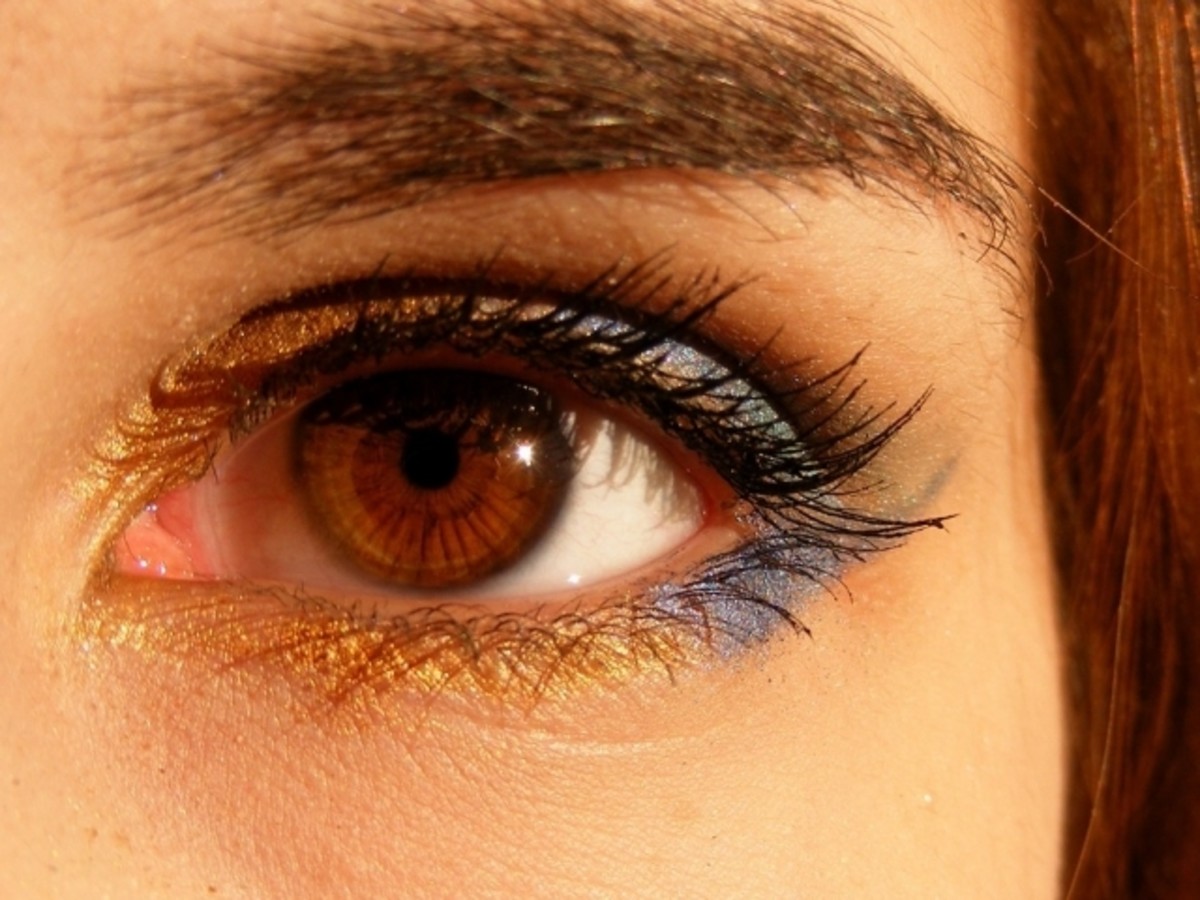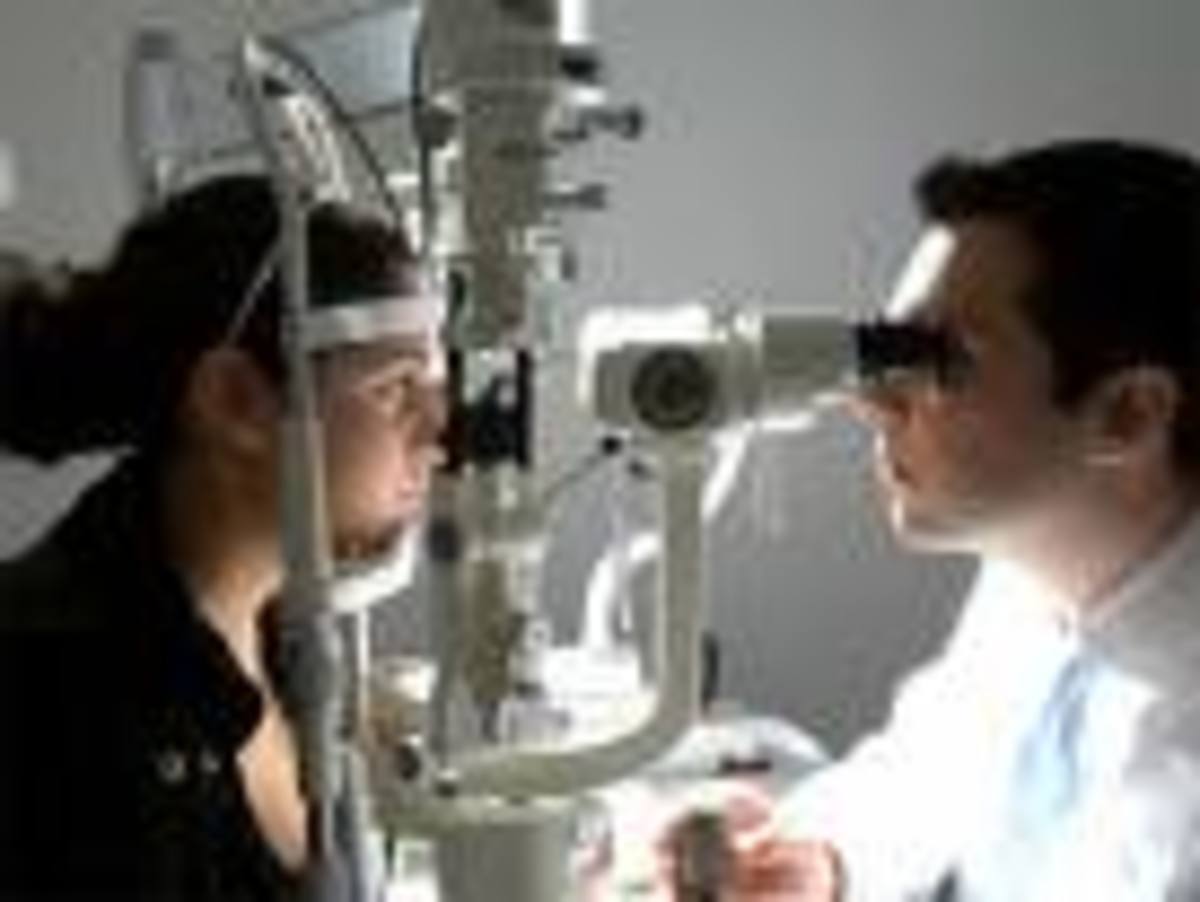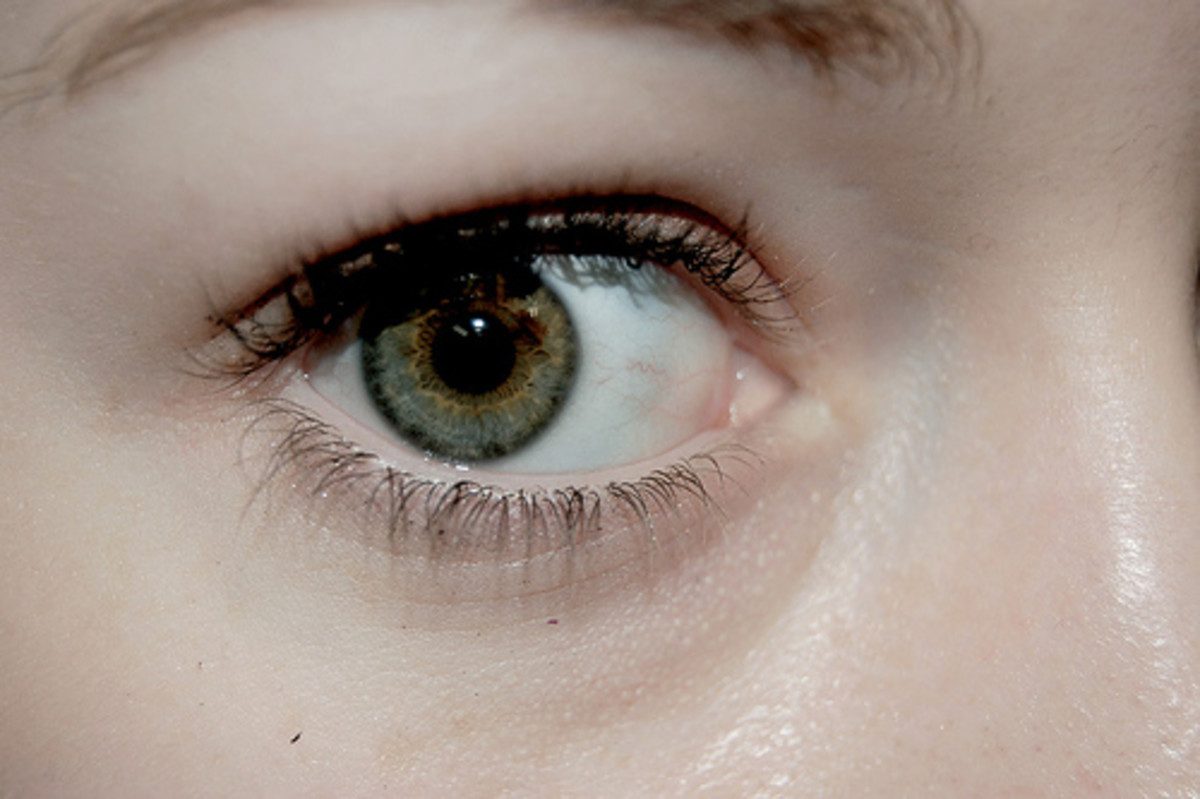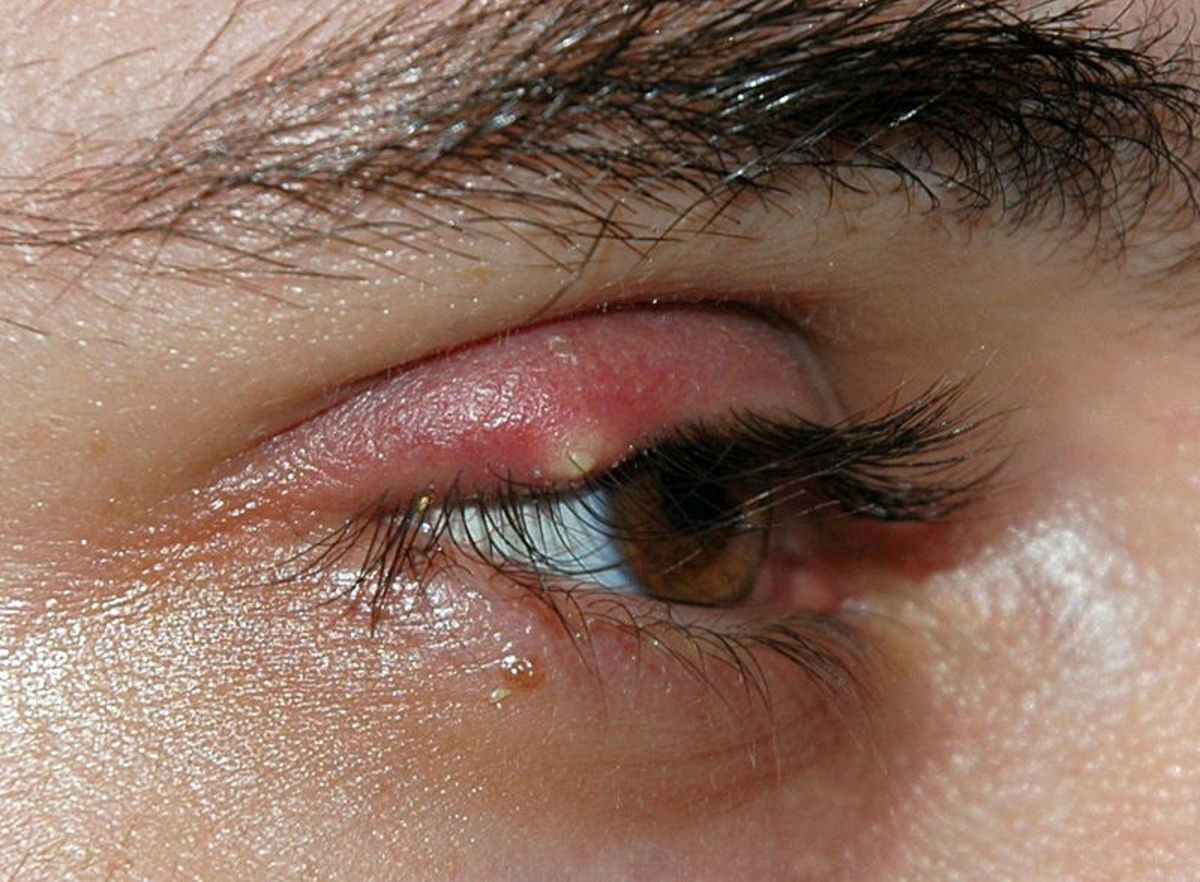Improve your sight without glasses
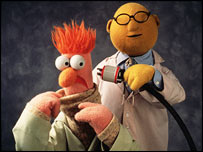
This one is eye opening in all senses.
Improving your sight without glasses is nothing new - it's nearly a century old yet it still feels like 'news' today, in fact more so because when it was discovered it was completely rejected. So what is this 'new' theory?
The name's Bates - the William H. Bates theory. The ultimate eye-spy.
I just happened to stumble across this one - quite literally stumble across it. While I was at my Grandpa's house last summer I found an old book stuck behind a chest of drawers and tugged it out.
'Improve your sight without glasses' was the title.
A book from the seventies with no author's name written on any part of it, just 'Reader's Digest'. Perhaps the author had gone into hiding from furious hoards of opticians because the book is quite clear in its message about glasses - 'they cannot remedy an eye defect but only add to the defect by making the eye dependent.'
The author writes enthusiastically about the Bates method and seems confident it will take off. If that author is still around today, whoever it was may be a little disappointed. Of course, I see from my research on the internet that the Bates method is still going strong but perhaps not as strong as it should be.
The author of my dusty little book points out, even then, that 'throughout the world industries have built up based on the 'need' for spectacles, and today's frames are made in such a wide and attractive range that a lot of people almost welcome the need to wear them.'
This sounds rather quaint today but that poor author's jaw would drop at the spectacle of 'spectacles' we see around us today. And all making for some very happy designers and opticians of course.
But actually although the optical industry does have vested interests in keeping us away from the Bates method the real reason why Bates isn't more widely used is that we ourselves are stopping it taking off.
The fact is, even if the Bates method was widely known I can't see it ever really taking the place of traditional methods. Simply because human beings can be inclined towards laziness sometimes and doing daily exercise to improve the sight is a bit too much like hard work. That's why things like the remote control exists - we know deep down that we should be getting up to change the channel but who can be bothered?
But the point is, we should be bothered.
As my little book argues, if we break our leg we put it in plaster and walk on crutches but we don't leave it that way. It's only a temporary measure while we work on getting that leg better. Why not do the same with the eyes? Why leave them in crutches forever?
And glasses are just that - crutches for eyes.
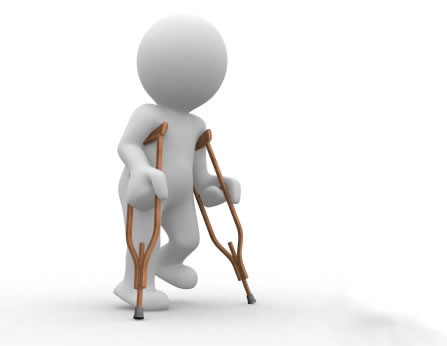
So what does it take to free yourself from those crutches? What it takes, as you will find out when you read, is a regular routine made up of correct exercises, diet, relaxation and vitamins.
The point is that this, in itself, takes quite an effort which, to a lot of people, will sound a bit too much like hard work. Even with the knowledge that glasses don't solve our eyesight problems and in fact makes them worse it's unlikely we're going to give them up - after all, they solve the problem on a temporary basis and that's enough.
In this hub I'll pass on the exercises, diet etc that benefit sight in such a way that, judging by the success rate, you won't need to use glasses anymore. Yep, you'll be aiming them at the bin or better still putting them on this winter's snowman.
But of course, the effort has to come from your side and if you know now that you don't want to put that effort in then I suggest you stop reading here.
Go on, off you go.
That said, for anyone impatient to know the methods and make a hasty decision, I'll tell you now what it'll entail:
- regular eye exercises (which I shall give to you further on)
- a correct diet
- visual relaxation (I'll explain this as well)
- correct reading habits
- sunbathing (with a difference)
- the correct vitamins
- blinking
And that's it in a nutshell but if you're interested you need to read on because that information alone will send you out to sea with no..well, glasses and still an eye defect to deal with.
So read on (but don't skim read because that's something else that plays havoc with your eyesight!)

Now the fact is that eyesight can be improved without glasses.
The British writer Aldous Huxley became a champion of the Bates method and as he says 'the proof of the pudding is in the eating'.
Huxley's sight deteriorated to the point that he was dependent on Braille for reading and needed a guide for walking.
The Bates method worked so well for him that he wrote a book 'The art of seeing' in which he raves about the Bates method. Huxley had been prescribed powerful glasses for reading but says that 'a measure of strain and fatigue was always present' and despite glasses his eyesight carried on failing. Pushed to desperation in 1939 he took a course of 'visual re-education' based on Bates' methods.
'Within a couple of months,' writes Huxley. 'I was reading without glasses and without strain and fatigue.'
Huxley goes on to compare the Bates method with the then (and still) traditional methods of dealing with failing sight. Huxley himself was treated by opticians 'of the highest eminence' but none pointed out that his problem may be a mental as well as physiological one.
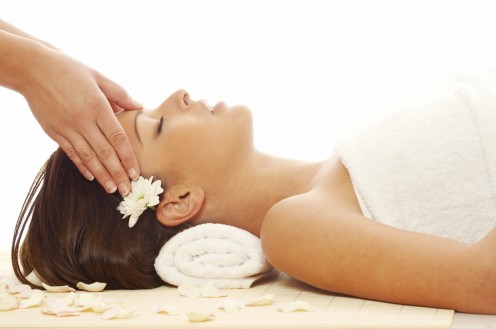
Mental relaxation = visual relaxation
Learning to relax is the most important step towards improving eyesight. As Huxley writes:
'learn to combine relaxation with activity - learn to do what you have to without strain - never under tension.'
So when approaching any of the Bates exercises it's important to be in a relaxed frame of mind, in other words you shouldn't be forcing yourself to exercise.
This is perhaps why people give up on the Bates method and deem it as useless. It seems pretty logical that if people are forcing themselves to do eye exercises morning and evening they won't reap much benefit from those exercises. So I would say it's also important to believe in the exercises and from there a natural willingness to follow them will come about.
For you to believe in them perhaps it's better if I explain why Bates himself (and many others) believe so firmly in the methods.
The fundamental difference between the Bates theory and the theory of Helmholtz (the man who created the traditional theory) is that Helmholtz sustained that eye problems are due to the crystalline lens whereas Bates believed the problem lay in the external muscles of the eye.
The two men obviously didn't see eye to eye (oops, sorry).
Following the Helmholtz theory the eye problem can be relieved by glasses but as my little book points out 'the cause of the problem has not been removed' and points out that 'the eye adapts itself as an invalid does to a crutch'.
Bates, on the other hand, believed that eye strain was not due to defective sight but was in fact its cause. Therefore, according to Bates, it was these weakened eye muscles which were bringing about poor eyesight, and not poor eyesight bringing about weakened eye muscles as Helmholtz believed. And whereas traditional methods considered faulty eyesight irreversable, Bates had a more optimistic view.
So let's go back to that leg in its plaster again. Supposing we didn't exercise those leg muscles, apply heat, massage etc but kept the leg wrapped up in plaster for always, is it likely to get better?
Of course, any theory is all well and good but without being tested it's just that - a theory. And Bates theory was put to the test and 'met with more than a degree of success' according to my book. Dr Peppard, who worked with Bates for many years (and later with the Beatles perhaps?) witnessed hundreds of people from the age of two to ninety discard their glasses and attain normal sight.
Well of the two theories I know which one I go for - one saves me 100 euro on glasses so I don't hesitate!
Ok, it's not just that - I know deep down that the best results come from your own hard work. And this, although perhaps not easy, is what Bates' method is all about.
Your own hard work.
So as regards mental relaxation, according to Peppard (a Bates follower) if the mind is tense then this is the very thing that causes eye strain. To relax the mind, this may sound obvious but first of all you must avoid putting it under pressure.
There is acute eye strain and chronic eye strain and here is what Peppard cites as the causes:
Acute
- using the eyes during a severe toxic condition e.g measles, tonsillitis, severe colds, 'flu etc, i.e reading or watching TV whilst ill.
Chronic
- using the eyes in bad light - either too dim or too strong, or with shafts of light invading your visual range,
- reading something held too close to or too far away from the eyes,
- reading whilst sitting in the incorrect posture or just plain uncomfortably,
- reading when tense, agitated, tired or in any unrelaxed state,
- reading badly printed material (too small print, glaring paper)
- skim reading or not focusing properly on something (practise central fixation constantly, that is to say get into the habit of looking at specific points).
He also warns that tooth decay, constipation, sinus troubles, headaches and living in an inharmonious atmosphere will cause constant eye strain.
My little book however points out that 'the eye is so wonderfully made that it will tolerate a fair degree of strain for years without the vision becoming defective' but when strain does manifest itself you may notice general fatigue, headaches, itchy, inflamed or watery eyes and blurry vision.
And when you get to this stage, before running off to the optician, read on.
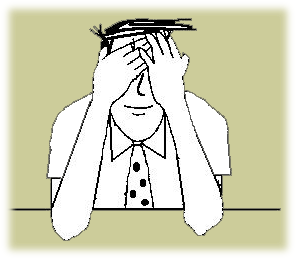
Eye Relaxation exercises
Palming
The first exercise is something you can try straight away.
You need to sit by a calender or something readable. Make sure you sitting comfortably and relaxed and take off your glasses (if you wear them). Cover your eyes gently with the palm of your hands (don't press down) and stay like that for a few minutes. Try to relax as much as possible - switch off the mind or think of something peaceful. You can rest your elbow on your knees or on a table to keep comfortable. When you take away your palms open your eyes and blink.
Have you done that?
You should notice the calender or whatever you were looking at (best not the computer screen) looks brighter and more distinct.
Didn't work? Perhaps you didn't do it long enough or relax enough.
You'll notice that you have to blink at the end of the exercise. According to my neat little book 'blinking is the first of the arts of visual relaxation.'
Remember to blink (butterfly blinks) as often as you can from now on, it keeps the eye healthy.
Swinging
Another way in which the eyes and surrounding tissue can be relaxed is by 'swinging'. According to my little book it 'has a soothing effect upon the whole nervous system' easing both body and mind simultaneously and is very effective in relieving eyestrain.'
The exercise goes like this - stand upright with your feet 12 inches (30 cm) apart, hands loosely at your sides; then, keeping as relaxed as you can, slowly sway the whole body from side to side as if you were the pendulum of a clock. At the same time raise each heel from the ground but not the whole foot.
This little exercise should be practised two or three times a day for five to ten minutes at a time or whenever the eyes are tired or aching.
Strengthening weak eye muscles
There are six sets of eye muscles and the next step in remedying weak eyesights is doing some 'eye muscle building'.
Now, you'll have to excuse me but I'm going to just copy the following exercises straight from the book as the instructions are already clear and concise. I'll still have to type them out though so give me a big round of applause at the end just the same.
First, if you wear glasses and have done for some time bear in mind that these eye muscles will be stiff and lacking flexibility so, to begin with, don't exercise to the point of making your eyes tired or sore. Increase them gradually over time.
Exercise 1
Keep the head still and look as far up as you can (without straining) and then down as far as you can. Repeat twelve times. Then relax. After each exercise blink rapidly.
Exercise 2
Move the eyes from left to right twelve times. Then relax and blink.
Exercise 3
Look down to your right side then up to your left eyebrow. Twelve times. Relax by blinking.(and do this after every exercise - I won't say it again).
Exercise 4
Look down at your left side, then up towards your right eyebrow. Twelve times
Exercise 5
Combine exercise 3 and 4 into one exercise. Twelve times.
Exercise 6
Move the eyes gently around in a circle, six times from right to left, then vice versa another six times.
Exercise 7
Hold up the index finger of the right hand about eight inches (20 cm) in front of the eyes, then look from the finger to any large object you like, ten or more feet (three metres) away - the door will do.
Look from one to the other ten times, then rest for a second and repeat the ten glances two or three times. Do this exercise fairly rapidly.
This is the best exercise for strengthening - it should be practised as often as you like and where you like (the book says this, not me! If you want to do it while queueing for the bus that's up to you, but you're on your own.)
Those are the exercises and as you might see they are quite a commitment, especially as you should carry them out at least twice a day to get results.
On the plus side of course, they can be done anywhere and at any moment so when the TV gets boring (as I'm sure it does) or you've got a quiet moment at work you could be practising waggling your finger in front of you! Remember to stop if you feel eye pain though (even though this is normal as you're exercising muscles that are stiff) and blink regularly in between. My little book also recommends the palming exercise at the end of each 'work out' to wind down.
Ah, but you haven't finished yet! There's also the neck to think about...
Neck Exercises
Some of the most important blood vessels and nerves lie in the neck therefore it's important to keep the neck relaxed so that the nerve and blood supply can travel freely to the eyes (and all other parts of the body for that matter).
Exercise 1
Slowly rotate the head a circle, keeping the rest of the body still. Repeat twelve times.
Exercise 2
Allow the head to drop as far forward as possible on to the chest keeping the neck relaxed and not stiff. Then raise the head and allow it to fall as far backwards as possible. Twelve times.
Following these two exercise morning and evening the blood vessels along the cervical vertebrae should function more freely and increase the flow of blood to the eyes and eye muscles.
So after that massive work out what better way to wind down than with a good eye bath! And now that you mention it...
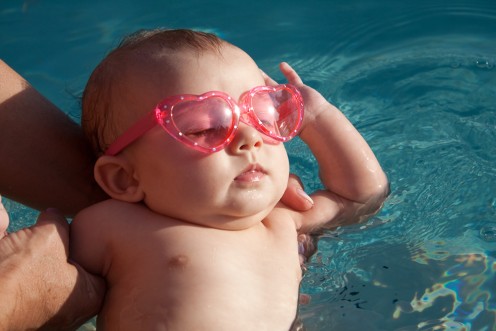
Eye sunbathing
According to my little book 'the popular notion that sunlight is bad for the eyes is another fallacy that has to be discarded'.
Today this statement perhaps wouldn't even be allowed in print (and I do wonder what has happened to the author of this book and whether he or she is locked up in some optician's cellar somewhere) but I find it quite refreshing.
All the same, I personally get one whiff of the sun and my eyes start watering. But, according to my author, sunglasses 'coddle' the eyes and keep them away from something that actually strengthens them - and that thing is the sun.
The fact that we can't stand the sun when we take off our 'dark goggles', as my author calls them, apparently reveals that:
1. Our diet is deficient in Vitamin A;
2. we have so many toxins in us that sunlight worsens our condition.
I'll explain the point about the Vitamin A - according to Professor McCollum an American scientist, Vitamin A allows for the regeneration of 'visual purple', a pigment in the eye that allows it to adapt from bright light to darkness. Therefore if we're not getting enough Vitamin A, bright light will be torture and in dim light we'll be groping around like moles. And similarly, with toxins it's all down to our diet - I'll come to the recommended diet in just a bit.
First, our old friend, the sun.
An American nutritionist Gayelord Hauser was converted to the Bates method and has this to say on the benefits of sunlight:
'Sunshine is valuable in all cases of eye trouble. Everyone should give their eyes a five minute bath whenever opportunity offers.'
Before you start running out to soak up the rays I would say the key here is the five minutes. Just like anything, excess is going to cancel out any benefits. Another thing to remember is that it's not enough to soak up sunlight that comes through the window - apparently glass filters out those vitamins. Hauser explains how to go about a 'sun bath'.
He recommends at first keeping the eyes closed and letting the sun fall on the lids. 'Turn your head from side to side so that the sun rays penetrate into all parts of the eyes. Sunshine and warmth are great healing agents' he wrote. 'They bring new blood and lymph supply to the eyes and surrounding muscles.
After you have practised the five minute sun bath for a week you should be able to blink at the sun'.
Hmmm, might not be trying that one myself but a bit of sun on the eyelids - yes, that sounds all right.
Also, as I've found out in the last few days through researching Vitamin D (the wonder vitamin for fighting colds, flu and other illnesses) the best source of it is, you've guessed it, the good old sun.
But now, you're probably thinking about that all important diet. Onwards.
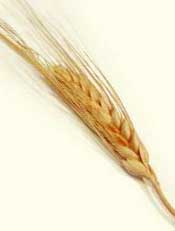
The proper diet for good sight
My little book states 'if you want to improve your sight then you must improve your health.'
Gayelord Hauser in his book 'better eyes without glasses' writes:
'Frequently the addition of Vitamin A has helped in improving eyesight. However, in more serious eye conditions a more thorough regimen has to be followed.'
Ok, so if you haven't got big eye problems you might want to skip the diet part but then again as Hauser points out 'nothing reflects uncleanliness like the eyes' so before you run off for a fry-up, just check your eyes first.
Apparently 'dull eyes show that the person is suffering from faulty elimination' and you don't want to be accused of that, now do you?
Also, as my little book points out 'the eye cannot be regarded as a separate part of the body - it is an integral part of the whole bodily function' and says 'it is therefore no better than the body's general health.' So if you're eating junk, I'm afraid your eyes are going to give this away (sooner or later).
'The practice of treating the eye as a separate entity is one of the major fallacies of orthodox ophthalmic science.'
So now for some munching. Here is what the 'good vision' diet should include:
- A breakfast with three dessertspoons of wheatgerm, eaten with milk and honey.
- Green leafy vegetables, lettuce, parsley and mint, raw carrot and beetroot, raw cabbage, chives, cress, tomatoes and plenty of fresh fruit.
- Plenty of dairy and wheatgerm throughout the day.
The important thing, according to my book, is that your diet is keeping you regular in your daily lavatory outing. In this way the blood stream is kept clean and as Hauser writes:
'With a pure blood stream, plus visual relaxation and visual and neck exercises, nothing short of miracles are possible in the restoration of good sight without glasses.'
I should add that there are a myriad of vitamins that are recommended for different eye complaints which I haven't included here but if you're interested in the Bates method I advise you seek out further information to suit your needs - there's a vitamin waiting at the side lines for every possible eye complaint out there.
The key thing with the diet is to eat healthy and wholesome foods even if you're not sticking rigidly to the above. 'All fourth rate foods should be eliminated from the diet' my little book tells me. These include cheapo white bread, white sugar, packaged food (even a lot of breakfast cereals), sauces, pickles, salty food, fried food, sweets and chocolate, biscuits...you get the idea. On the other hand the 'vital' foods should be eaten as much as possible, i.e green vegetables, fruit, etc.
I'm coming to the end now and I really hope you didn't skim read because as I say, that's one of the no-nos.
So now you know the 'controversial' Bates method - I can't see what's controversial about it myself - as far as I can see, if you're committed, it works; if you're not, it doesn't - the only thing controversial is that it discourages people from piling their money into pairs of glasses.
Before I finish here are a few essential points to remember:
- Splash cold water on your eyes first thing in the morning to get the circulation going in the eyes. You can also do this when your eyes are sore or tired.
- Try to 'sunbathe' your eyes every day if possible.
- It's not always possible but try to keep a serene mind - if you're tense or irritated, try relaxing the mind (by palming or swinging) before you put your eyes to work.
- Get your teeth checked by your dentist (or whoever checks your teeth) - unhealthy teeth can cause eye problems.
- Adopt the correct posture and good reading habits : never read when ill or very tired; when reading you should sit upright and relaxed holding the book upright about 14 inches (35 cm) from the eyes with a good reading light directed on the page (but there should be no light or reflected light shining in your field of vision) and remember to blink regularly during reading. Avoid reading badly printed material (blight, glaring paper, clashing colours etc) and avoid skim reading.
- Eat wholesome foods - the eye will reflect this. Any debauchery will eventually be given away in your eyes - just like in Dorian Grey's painting.
- Take the correct vitamins for your eye trouble and for free vitamins - sun, sun, sun!
All this combined, according to the nutritionist Hauser, should perform nothing short of a miracle!
Then again, I haven't regularly followed the exercises yet but I can assure you that after spending hours in front of the computer writing this hub I will be trying them out. Of course, like all things, there will be people who say this theory is no good but they're welcome to go and spend their money at the opticians.
Aldous Huxley raved about the Bates method though and from someone whose sight failed almost completely, his enthusiasm does at least merit curiosity.
Happy vision!



